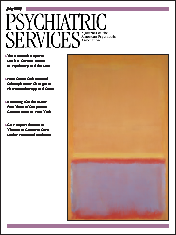Pharmacotherapy and Health Care Costs Among Patients With Schizophrenia and Newly Diagnosed Diabetes
Abstract
OBJECTIVE: This study investigated how antipsychotic pharmacotherapy and health care costs change after diabetes mellitus is newly diagnosed among patients with schizophrenia. METHODS: Administrative data from the Department of Veterans Affairs were retrospectively reviewed to examine patients with schizophrenia who did not have any history of diabetes and for whom a consistent regimen of antipsychotic monotherapy was prescribed for any three-month period between June 1999 and September 2000. Data for these patients were reviewed through September 2001. Patients who were given a new diagnosis of diabetes were identified, along with a matched comparison group of patients who were not given a diagnosis of diabetes. Medication changes and costs were compared between patients with diabetes and those without and between patients who were taking second-generation antipsychotics and those who were taking first-generation antipsychotics. RESULTS: Of the 56,849 patients who fit the criteria for the study, 4,132 (7.3 percent) were subsequently given a diagnosis of diabetes (7.4 percent were taking second-generation antipsychotics and 7.1 percent were taking first-generation antipsychotics). Differences in the proportions of patients with and without diabetes who switched or discontinued antipsychotics were small and were statistically significant only for patients who were taking risperidone before the diabetes diagnosis date. The average marginal cost of treating a patient with diabetes was $3,104 over an average follow-up of 15.7 months, or $6.59 per day. Because the attributable risks of diabetes with second-generation antipsychotics averaged .875 percent, the average additional daily cost per patient that was attributable to each second-generation medication was small, ranging from $.003 for risperidone to $.134 for clozapine. CONCLUSIONS: Surprisingly, a new diagnosis of diabetes did not result in substantial antipsychotic medication changes, even among patients who were taking clozapine or olanzapine. Even though the costs of treating patients with newly diagnosed diabetes were substantial, the increased costs attributable to second-generation antipsychotics were small.



